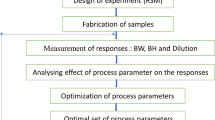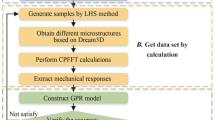Abstract
Cu–W nanocomposites had many engineering applications due to the unique characteristics including hardness, transverse rupture strength, electrical conductivity, thermal conductivity, and relative density. This study was an attempt to used gene expression programming as a powerful soft computing technique to model the parameters for the synthesis of Cu–W nanocomposite prepared by spark plasma sintering. First, 97 different reliable experiments were carried out considering the type of Cu and W concentration, temperature, die pressure, and heat rate as input variables. The hardness, transverse rupture modules, electrical conductivity, thermal conductivity, and relative density of nanocomposite defined as output variable separately. An absolute fraction of variance (R2), mean absolute percentage error (MAPE), root relative squared error (RRSE), and mean squared error (MSE) were considered to validate the most appropriate GEP models. Sixfold cross validation was used through testing and training steps of GEP modeling. The results were divided randomly into 68 training sets and 29 testing sets. Finally, the best GEP models were selected for each output parameter. Sensitivity analyses are done to determine the rank of the practical parameters on each investigated properties and revealed that on hardness, transverse rupture modules, electrical conductivity, thermal conductivity, and relative density of nanocomposite, respectively. The results confirmed the ability of GEP for all parameters of Cu–W nanocomposites prepared by spark plasma sintering.






Similar content being viewed by others
References
Hiraoka Y, Inoue T, Hanado H, et al. Ductile-to-brittle transition characteristics in W-Cu composites with increase of Cu content. J Mater Trans Commun. 2005;46(7):1663–70. https://doi.org/10.2320/matertrans.46.1663.
Hanado H, Hiraoka Y. Localized deformation behavior of W–80 vol%Cu composite at room temperature. J Mater Trans Commun. 2007;48(4):775–9. https://doi.org/10.2320/matertrans.48.775.
Ryu SS, Kim YD, Moon IH. Dilatometric analysis on the sintering behavior of nanocrystalline W-Cu prepared by mechanical alloying. J Alloys Comp Commun. 2002;335(1–2):233–40. https://doi.org/10.1016/S0925-8388(01)01805-9.
Wang WS, Kwang KS. The effect of tungsten particle size on the processing and properties of infiltrated W-Cu compacts. J Metall Trans Commun. 1998;29A:1509–16. https://doi.org/10.1007/s11661-998-0366-9.
Mordike BL, Kaczmar J, Kielbinski M, et al. Effect of tungsten content on the properties and structure of cold extruded Cu–W composite materials. J Powder Metall Int Commun. 1991;23:91–5.
Ho PW, Li QF, Fuh JYH. Evaluation of W-Cu metal matrix composites produced by powder injection molding and liquid infiltration. J Mater Sci Eng Commun. 2008;485:657–63. https://doi.org/10.1016/j.msea.2007.10.048.
Amirjan M, Zangeneh-Madar K, Parvin N. Evaluation of microstructure and contiguity of W/Cu composites prepared by coated tungsten powders. Int J Refract Met Hard Mater Commun. 2009;27(4):729–33. https://doi.org/10.1016/j.ijrmhm.2008.12.008.
Yunping L, Yu S. Thermal–mechanical process in producing high dispersed tungsten–copper composite powder. Int J Refract Met Hard Mater Commun. 2008;26:540–8. https://doi.org/10.1016/j.ijrmhm.2008.01.001.
Ibrahim A, Abdallah M, Mostafa SF, et al. An experimental investigation on the W-Cu composites. J Mater Des Commun. 2009;30:1398–403. https://doi.org/10.1016/j.matdes.2008.06.068.
Dongdong G, Shen Y. Influence of Cu–liquid content on densification and microstructure of direct laser sintered submicron W-Cu/micron Cu powder mixture. J Mater Sci Eng A Commun. 2008;489:169–77. https://doi.org/10.1016/j.msea.2007.12.008.
Luo S, Yi J, Guo Y, et al. Microwave sintering W–Cu composites: analyses of densification and microstructural homogenization. J Alloys Comp Commun. 2009;473:L5–9. https://doi.org/10.1016/j.jallcom.2008.05.038.
Da Costa FA, da Silvab AGP, Gomes UU. The influence of the dispersion technique on the characteristics of the W-Cu powders and on the sintering behavior. J Powder Technol Commun. 2003;134:123–32. https://doi.org/10.1016/S0032-5910(03)00123-2.
Bhattacharya M, Basak T. A review on the susceptor assisted microwave processing of materials. J Energy Commun. 2016;97:306–38. https://doi.org/10.1016/j.energy.2015.11.034.
Li D, Liu Z, Yu Y, et al. Research on the densification of W–40 wt.%Cu by liquid sintering and hot-hydrostatic extrusion. Int J Refract Metals Hard Mater Commun. 2008;26:286–9. https://doi.org/10.1016/j.ijrmhm.2007.06.004.
Li D, Liu Z, Yu Y, et al. The influence of mechanical milling on the properties of W–40 wt.%Cu composite produced by hot extrusion. J Alloys Comp Commun. 2008;462:94–8. https://doi.org/10.1016/j.jallcom.2007.08.042.
Rodriguez P, Caussat B, Ablitzer C, et al. Alumina coating on dense tungsten powder by fluidized bed metal organic chemical vapour deposition. J Nanosci Nanotechnol Commun. 2011;11(9):8083–8. https://doi.org/10.1166/jnn.2011.5097.
Li DR, Liu ZY, Yu Y, et al. Numerical simulation of hot hydrostatic extrusion of W–40 wt.% Cu. J Mater Sci Eng Commun. 2009;499:118–22. https://doi.org/10.1016/j.msea.2007.11.125.
Zhou Z, Du J, Song S, et al. Microstructural characterization of W/Cu functionally graded materials produced by a one-step resistance sintering method. J Alloys Comp Commun. 2007;428:146–50. https://doi.org/10.1016/j.jallcom.2006.03.073.
Lin T, Yin S, Wei YP. In-situ reaction used in producing composites by casting process. J Mater Rev Commun. 2001;14:30–1.
Gill SC, Zimmermann M, Kurz W. Resolidification of the Al–Al2Cu eutectic the coupled zone. J Acta Mater Commun. 1992;40(11):2895–906. https://doi.org/10.1016/0956-7151(92)90454-M.
Liang SH, Hu R, Fan ZK. Microstructure and properties of CuCr series pseudobinary alloy by arc melting. J Spec Cast Nonferrous Alloys Commun. 2000;4:25–6.
Zhao F, Xu H, et al. Preparation of CuCr25 alloys through vacuum arc-smelting and their properties. J Trans Nonferrous Met Soc Commun. 2000;10(1):73–5.
Shi YM, Xu YH, et al. Preparation of fiber-structured W/Cu contact materials. Foundry Technol. 2006;27(1):1238–40.
Duan LH, Lin WS, et al. Thermal properties of W-Cu composites manufactured by copper infiltration into tungsten fiber matrix. J Int J Refract Met Hard Mater Commun. 2014;46:96–100. https://doi.org/10.1016/j.ijrmhm.2014.05.022.
Liang SH, Chen L, et al. Infiltrated W-Cu composites with combined architecture of hierarchical particulate tungsten and tungsten fibers. J Mater Charact Commun. 2015;110:33–8. https://doi.org/10.1016/j.matchar.2015.10.010.
Cheng JG, Wan L, et al. Fabrication of W–20 wt% Cu alloys by powder injection molding. J Mater Process Technol Commun. 2010;210:137–42. https://doi.org/10.1016/j.jmatprotec.2009.08.001.
Tang XQ, Zhang HB, et al. Fabrication of W-Cu functionally graded material by spark plasma sintering method. Int J Refract Met Hard Mater Commun. 2014;42:193–9. https://doi.org/10.1016/j.ijrmhm.2013.09.005.
Elsayed A, Li W, et al. Experimental investigations on the synthesis of W-Cu nanocomposite through spark plasma sintering. J Alloys Compd Commun. 2015;639:373–80. https://doi.org/10.1016/j.jallcom.2015.03.183.
Autissier E, Richou M, et al. Elaboration and thermomechanical characterization of W/Cu functionally graded materials produced by Spark Plasma Sintering for plasma facing components. Fus Eng Des Commun. 2015;98–99:1929–32. https://doi.org/10.1016/j.fusengdes.2015.05.066.
Raghu T, Sundaresan R, Ramakrishnan P, et al. Synthesis of nanocrystalline copper–tungsten alloys by mechanical alloying. J Mater Sci Eng A Commun. 2001;304–306:438–41. https://doi.org/10.1016/S0921-5093(00)01444-1.
Hoseinian FS, Faradonbeh RS, Abdollahzadeh A, Rezai B, Soltani-Mohammadi S. Semi autogenous mill power model development using gene expression programming. Powder Technol Commun. 2017;308:61–9. https://doi.org/10.1016/j.powtec.2016.11.045.
Ferreira, C. Gene expression programming: a new adaptive algorithm for solving problems. J Complex Systems. common. 2001. Vol. 13, issue 2: 87-129 cs/0102027.
Rostami A, Ebadi H. Toward gene expression programming for accurate prognostication of the critical oil flow rate through the choke: correlation development. Asia-Pac J Chem Eng Commun. 2017;12:884–93. https://doi.org/10.1002/apj.2126.
Rostami A, Shokrollahi A. Accurate prediction of water dewpoint temperature in natural gas dehydrators using gene expression programming approach. J Mol Liq Commun. 2017;243:196–204. https://doi.org/10.1016/j.molliq.2017.08.045.
Ouaer H, Hosseini AH, Nait Amar M, Ben Seghier MEA, Ghriga MA, Nabipour N, Andersen PØ, Mosavi A, Shamshirband S. Rigorous connectionist models to predict carbon dioxide solubility in various ionic liquids. J Appl Sci Commun. 2020;10:304. https://doi.org/10.3390/app10010304.
Baykasoğlu A, Güllü H, Çanakçı H, Özbakır L. Prediction of compressive and tensile strength of limestone via genetic programming. Expert Syst Appl. 2008;35(1–2):111–23.
Teodorescu L, Sherwood D. High energy physics event selection with gene expression programming. Comput Phys Commun. 2008;178:409–19. https://doi.org/10.1016/j.cpc.2007.10.003.
Shojaei MR, Khayati GHR, Hasani A. Utilization of gene expression programming for modeling of mechanical performance of titanium/carbonated hydroxyapatite nanobiocomposites: the combination of artificial intelligence and material science. J Int J Eng Commun. 2021;34(4):948–55. https://doi.org/10.5829/ije.2021.34.04a.21.
Ferreira C. Gene expression programming in problem solving. Soft computing and industry. Berlin: Springer; 2002. p. 635–53. https://doi.org/10.1007/978-1-4471-0123-9_54.
Mousavi SM, Aminian P, Gandomi AH, Alavi AH, Bolandi H. A new predictive model for compressive strength of HPC using gene expression programming. J Adv Eng Softw Commun. 2012;45(1):105–14. https://doi.org/10.1016/j.advengsoft.2011.09.014.
Hosmer WD. Assessing the fit of the model. J Appl Logist Regres Commun. 2000. https://doi.org/10.1016/B978-0-12-809633-8.20349-X.
Johari, A., and M. Nakhaee. Maximum lateral displacement prediction of bored pile wall in granular soil using Gene Expression Programming. National Congress on Civil Engineering, University of Sistan and Baluchestan, Zahedan, Iran. 2013.
Sattari R, Khayati GR. Prediction of the size of silver nanoparticles prepared via green synthesis: a gene expression programming approach. J Sci Iran Commun. 2020. https://doi.org/10.24200/sci.2020.53209.3112.
Abdellahi M, Najafinezhad A, Ghayour H, Saber-Samandari S, Khandan A. Preparing diopside nanoparticle scaffolds via space holder method: Simulation of the compressive strength and porosity. J Mech Behav Biomed Mater Commun. 2017;72:171–81. https://doi.org/10.1016/j.jmbbm.2017.05.004.
Gandomi AM, Alavi AH, Gandomi M, Kazmi S. Formulation of shear strength of slender RC beams using gene expression programming, part II: With shear reinforcement. J Meas Commun. 2017;95:367–76. https://doi.org/10.1016/j.measurement.2016.10.024.
Akin O, Samuel A. Modelling of concrete compressive strength admixed with GGBFS using gene expression programming. J Soft Comput Civil Eng Commun. 2019;3(2):43–53. https://doi.org/10.22115/scce.2019.178214.1103.
Gesoglu M, Guneyisi E, Ozturan T, Ozbay E. Modeling the mechanical properties of rubberized concretes by neural network and genetic programming. J Mater Struct Commun. 2010;43(1):31–45. https://doi.org/10.1617/s11527-009-9468-0.
Azimi-Pour M, Eskandari-Naddaf H. ANN and GEP prediction for simultaneous effect of nano and micro silica on the compressive and flexural strength of cement mortar. J Constr Build Mater Commun. 2018;189:978–92. https://doi.org/10.1016/j.conbuildmat.2018.09.031.
Shahmansouri A, Bengar H, Jahani E. Predicting compressive strength and electrical resistivity of eco-friendly concrete containing natural zeolite via GEP algorithm. J Constr Build Mater Commun. 2019;229: 116883. https://doi.org/10.1016/j.conbuildmat.2019.116883.
Severcan MH. Prediction of splitting tensile strength from the compressive strength of concrete using GEP. J Neural Comput Appl Commun. 2012;21:1937–45. https://doi.org/10.1007/s00521-011-0597-3.
Shojaei MR, Khayati GHR, Hosseinipor H, Khorasani SMJ, Kafi R. Investigation of spring back phenomenon in the 316L stainless steel cathode blank based on the changes in electrical resistivity and magnetic properties due to the residual stress and martensite phase formation: an industrial failure. J Eng Fail Anal Commun. 2021. https://doi.org/10.1016/j.engfailanal.2021.105473.
Author information
Authors and Affiliations
Corresponding author
Ethics declarations
Conflict of Interest
The authors (Mohammad Reza Shojaei; Gholam Reza Khayati) certify that they have NO affiliations with or involvement in any organization or entity with any financial interest (such as honoraria; educational grants; participation in speakers’ bureaus; membership, employment, consultancies, stock ownership, or other equity interest; and expert testimony or patent-licensing arrangements), or non-financial interest (such as personal or professional relationships, affiliations, knowledge or beliefs) in the subject matter or materials discussed in this manuscript.
Additional information
Publisher's Note
Springer Nature remains neutral with regard to jurisdictional claims in published maps and institutional affiliations.
This article is part of the topical collection “Advanced Machine Learning Approaches in Cognitive Computing” guest edited by Kuntpong Woraratpanya and Phayung Meesad.
Rights and permissions
About this article
Cite this article
Shojaei, M., Khayati, G.R. Defined an Optimized Molding for Physical and Mechanical Properties of W–Cu Nanocomposite Through Spark Plasma Sintering Using Gene Expression Programming: The Combination of Artificial Intelligence and Material Science. SN COMPUT. SCI. 3, 37 (2022). https://doi.org/10.1007/s42979-021-00901-4
Received:
Accepted:
Published:
DOI: https://doi.org/10.1007/s42979-021-00901-4




